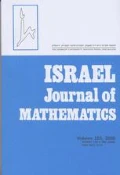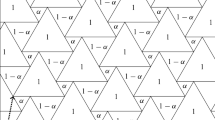Abstract
Let ℭ be a tiling of the plane such that each tile of ℭ meets at most finitely many other tiles. Then exactly one of the following must occur:
-
(1)
Uncountably many boundary points of ℭ belong to no nondegenerate edge of ℭ, hence ℭ has uncountably many singular points; or
-
(2)
Every boundary point of ℭ belongs to a nondegenerate edge of ℭ, moreover, ℭ has no singular points.
Furthermore, ifS is the set of singular points of ℭ andW={t:t∈bdry ℭ andt belongs to no nondegenerate edge of ℭ}, thenS=clW.
Similar content being viewed by others
References
Marilyn Breen,A characterization theorem for tilings having countably many singular points, J. Geometry21 (1983), 131–137.
B. Grünbaum and G. C. Shephard,Tilings and Patterns, W. H. Freeman, San Francisco (to appear).
Alain Valette,Tilings of the plane by topological disks, Geometriae Dedicata11 (1981), 447–454.
Author information
Authors and Affiliations
Rights and permissions
About this article
Cite this article
Breen, M. Tilings whose members have finitely many neighbors. Israel J. Math. 52, 140–146 (1985). https://doi.org/10.1007/BF02776087
Received:
Revised:
Issue Date:
DOI: https://doi.org/10.1007/BF02776087




